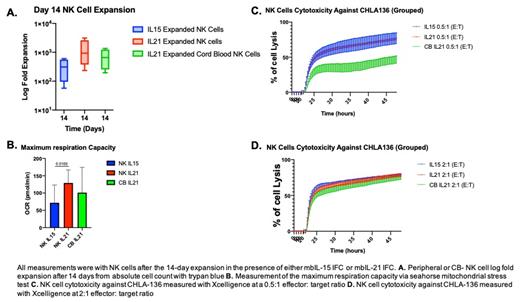Abstract
Introduction
As the field of cancer immunotherapy progresses, natural killer (NK) cells have become an ideal candidate for targeting multiple types of cancer. These cells are able to selectively target virally infected cells and tumor cells without damaging the healthy cells of the immune system making them an ideal candidate for treatment in AML, CML, MM, Neuroblastoma, Breast Cancer, and Renal Cell Carcinoma. While NK cells have shown their potential as immunotherapy agents, one of the biggest challenges includes expanding and harvesting enough cells for multiple transfusions when there are limited numbers of starting cells. Our group developed an NK cell expansion platform utilizing membrane bound-IL21 (mbIL-21), which allows for sustained proliferation in order to generate high numbers of cells. Continued research supported that mbIL-21 enables sustained NK cell proliferation compared to mbIL-15 due to mbIL-21 activation through STAT3 signaling. Recent shifts to umbilical cord blood have led to research using cord blood (CB) derived NK cells. However, this presents a challenge as a viable clinical option as others have shown that the expansion of these CB-derived NK cells have been shown to produce less potent NK cells. Here, we will use feeder cells expressing either mbIL15 or mbIL21 to expand NK cells (as is currently done in clinical trials), to deeply compare and contrast the impact of these two cytokines on NK cell biology and simultaneously compare and contrast the use of peripheral-derived NK cells and CB-derived NK cells.
Methods
NK cells were obtained from healthy donor leukopacks (n =4) and isolated using RosetteSep human NK cell enrichment cocktail. These samples were stimulated with either mbIL-21 or mbIL-15 irradiated feeder cells (IFC) and cultured in AIM-V media supplemented with 100 I/U of IL-2 and immune cell serum replacement (ICSR). Cord Blood NK cells were obtained from OrganaBio (n=4) and stimulated with mbIL-21 IFC . The cells were cultured in AIM-V media supplemented with 100 I/U of IL-2 and ICSR (complete media). All NK cell expansions were stimulated at day 0 and day 7, as previously described, and cell cultures were assessed every 2-3 days keep cells at an optimal concentration by supplementing with complete media. Cells were collected at day 14 to capture a picture before mbIL-15 expanded cells became senescent and were immediately used for cytokine production assays, RNA collected, ATAC-seq collection, and CyTOF fixation. The remaining cells were frozen for cytotoxicity assays, mitochondrial function assays, and degranulation assays. For mitochondrial function and cytotoxicity assays, cells were thawed and cultured in complete media for two days before use.
Results
Overall, the peripheral blood NK cells expanded with mbIL21 showed an increase in expansion at day 14 when compared to those expanded with mbIL15. NK cells expanded with mbIL21 demonstrated a more consistent cytotoxicity profile against CHLA-136, a neuroblastoma cell line, compared to mbIL21 expanded NK cells when cultured at a 0.5:1 ratio (E:T). While the results were not statistically significant at 14 days, previous data demonstrates that we see increased changes at 21 days. Of note, we had an overall more reproducible serial killing ability in the IL21 expanded samples compared to the variability observed in IL15-expanded samples. We saw a significant difference (p < 0.0001) in peripheral blood NK cells expanded with mbIL21 compared to cb-NK cells expanded with mbIL21 with a 0.5:1 ratio (E:T) against CHLA136. mbIL-21 expanded peripheral blood NK cells had a higher maximum respiration capacity than those expanded with mbIL-15 when measured under mitochondrial stress via seahorse assay (p= 0.016).
Conclusions
Our data showed that the cells began to show a different phenotypic profile at day 14 depending on the type of NK cell and the type of cytokine used for stimulation. By day 14 data supported that mbIL-21 expanded cells can better survive under low glucose conditions such as tumor microenvironments than mbIL15 expanded cells. The cytotoxicity data demonstrated that peripheral derived NK cells have improved serial killing ability than the cb-NK cells and we will continue to test their ability against additional tumor cell lines that have various HLA-typing. To further elucidate these differences, we will use our RNA-seq, ATAC-seq, and CyTOF data to understand what is causing the different profiles.
Lee: Kiadis Pharma: Divested equity in a private or publicly-traded company in the past 24 months, Honoraria, Membership on an entity's Board of Directors or advisory committees, Patents & Royalties, Research Funding; Courier Therapeutics: Current holder of individual stocks in a privately-held company.


This feature is available to Subscribers Only
Sign In or Create an Account Close Modal